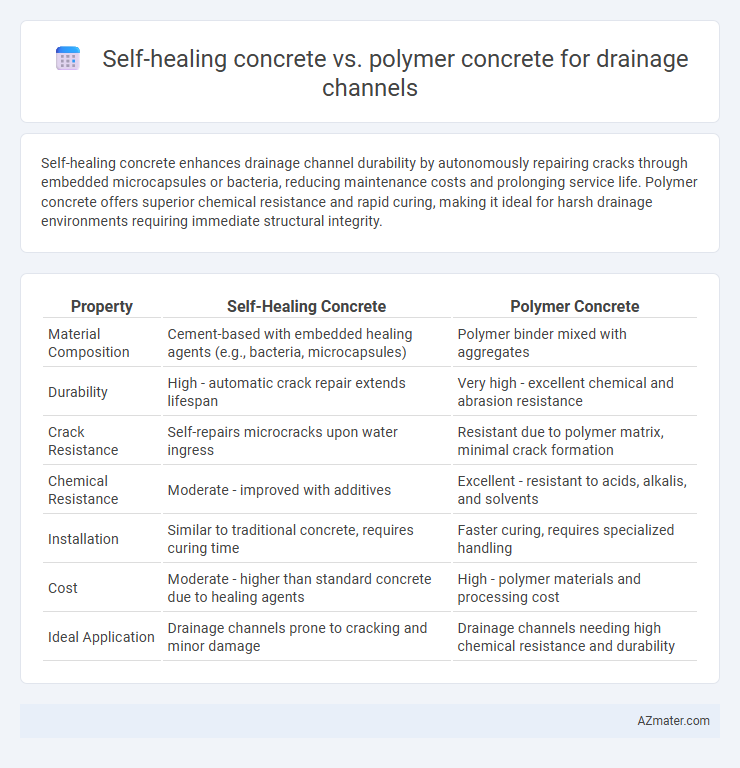Self-healing concrete enhances drainage channel durability by autonomously repairing cracks through embedded microcapsules or bacteria, reducing maintenance costs and prolonging service life. Polymer concrete offers superior chemical resistance and rapid curing, making it ideal for harsh drainage environments requiring immediate structural integrity.
Table of Comparison
| Property | Self-Healing Concrete | Polymer Concrete |
|---|---|---|
| Material Composition | Cement-based with embedded healing agents (e.g., bacteria, microcapsules) | Polymer binder mixed with aggregates |
| Durability | High - automatic crack repair extends lifespan | Very high - excellent chemical and abrasion resistance |
| Crack Resistance | Self-repairs microcracks upon water ingress | Resistant due to polymer matrix, minimal crack formation |
| Chemical Resistance | Moderate - improved with additives | Excellent - resistant to acids, alkalis, and solvents |
| Installation | Similar to traditional concrete, requires curing time | Faster curing, requires specialized handling |
| Cost | Moderate - higher than standard concrete due to healing agents | High - polymer materials and processing cost |
| Ideal Application | Drainage channels prone to cracking and minor damage | Drainage channels needing high chemical resistance and durability |
Introduction to Innovative Drainage Channel Materials
Self-healing concrete incorporates microcapsules or bacteria that activate to repair cracks autonomously, enhancing durability and reducing maintenance costs in drainage channels. Polymer concrete, composed of synthetic resins and aggregates, offers superior chemical resistance, rapid curing, and high tensile strength, making it ideal for harsh environmental conditions. Both materials represent innovative advancements targeting extended lifespan and performance optimization in modern drainage infrastructure.
Understanding Self-Healing Concrete: Mechanism and Benefits
Self-healing concrete utilizes embedded microcapsules or bacteria to autonomously repair cracks, enhancing durability and reducing maintenance costs in drainage channels. Its mechanism involves the release of healing agents upon crack formation, which precipitate calcium carbonate to seal fissures, thereby preventing water ingress and structural degradation. Compared to polymer concrete, which relies on synthetic resins for water resistance, self-healing concrete offers long-term sustainability by actively restoring integrity rather than merely providing a barrier.
What is Polymer Concrete? Composition and Key Features
Polymer concrete is a composite material where a polymer binder, typically epoxy or polyester resin, replaces traditional cement, combined with aggregates like sand, gravel, or quartz. Its key features include high chemical resistance, superior adhesion, low permeability, and rapid curing, making it ideal for drainage channels exposed to harsh environments. The enhanced durability and mechanical strength of polymer concrete reduce maintenance needs compared to traditional concrete alternatives.
Comparative Durability: Self-Healing Concrete vs Polymer Concrete
Self-healing concrete offers superior durability for drainage channels by autonomously repairing micro-cracks through embedded bacteria or chemical agents, reducing maintenance frequency and extending lifespan. Polymer concrete exhibits excellent chemical resistance and high tensile strength, but may be more susceptible to UV degradation and thermal cycling compared to self-healing variants. Evaluations in harsh environmental conditions show self-healing concrete's regenerative properties significantly outperform polymer concrete's static durability in long-term structural integrity.
Performance in Harsh Drainage Environments
Self-healing concrete exhibits superior durability in harsh drainage environments by autonomously sealing cracks caused by chemical exposure and mechanical stress, significantly reducing maintenance frequency. Polymer concrete offers excellent chemical resistance and mechanical strength, yet lacks intrinsic crack repair, potentially leading to long-term permeability issues. The choice between self-healing and polymer concrete hinges on prioritizing autonomous repair capabilities versus immediate chemical resilience in aggressive drainage conditions.
Installation and Maintenance Requirements
Self-healing concrete in drainage channels reduces maintenance frequency by autonomously repairing micro-cracks, minimizing water infiltration and structural deterioration. Polymer concrete offers faster installation due to its lightweight properties and chemical resistance, but requires periodic inspections to monitor polymer degradation under severe environmental conditions. Choosing between the two materials depends on balancing long-term maintenance cost savings with initial installation efficiency in drainage infrastructure projects.
Environmental Impact and Sustainability
Self-healing concrete reduces environmental impact by minimizing maintenance needs and extending the lifespan of drainage channels, thus lowering resource consumption and waste generation. Polymer concrete offers chemical resistance and durability but relies on petrochemical-based resins, which raise concerns about sustainability and carbon footprint. Choosing self-healing concrete supports circular economy goals through its eco-friendly microcapsules, whereas polymer concrete presents challenges due to limited recyclability and higher environmental costs.
Cost Analysis: Initial Investment and Lifecycle Cost
Self-healing concrete offers a higher initial investment compared to polymer concrete due to its advanced materials and technology but reduces long-term maintenance expenses by autonomously repairing micro-cracks. Polymer concrete, while generally cheaper upfront, often incurs increased lifecycle costs because of its susceptibility to cracking and degradation in drainage channel applications. Evaluating both materials for drainage channels requires balancing the upfront cost premium of self-healing concrete against the potential savings from its extended durability and reduced repair frequency.
Real-World Applications and Case Studies
Self-healing concrete demonstrates significant advantages in drainage channel applications by autonomously repairing micro-cracks, thus extending structural lifespan and reducing maintenance costs in urban infrastructure projects worldwide. Polymer concrete, known for its high chemical resistance and rapid curing properties, is widely utilized in corrosive environments such as industrial drainage systems and wastewater treatment plants, ensuring durability under aggressive conditions. Case studies from cities like Singapore and Rotterdam highlight self-healing concrete's performance in minimizing infiltration and improving sustainability, while polymer concrete installations in petrochemical facilities emphasize its resilience against harsh chemicals and mechanical stresses.
Choosing the Right Concrete for Drainage Channels
Self-healing concrete offers enhanced durability by autonomously repairing micro-cracks, reducing maintenance costs and extending the lifespan of drainage channels. Polymer concrete provides superior chemical resistance and rapid curing times, making it ideal for environments exposed to aggressive wastewater or chemicals. Selecting the right concrete depends on specific site conditions, with self-healing concrete best for long-term structural integrity and polymer concrete suited for high-chemical-exposure areas in drainage infrastructure.

Infographic: Self-healing concrete vs Polymer concrete for Drainage channel
 azmater.com
azmater.com